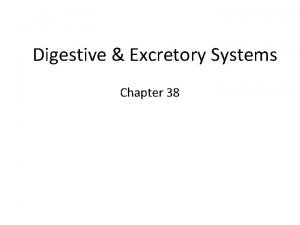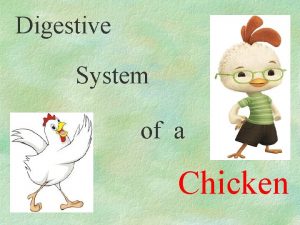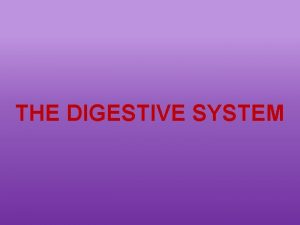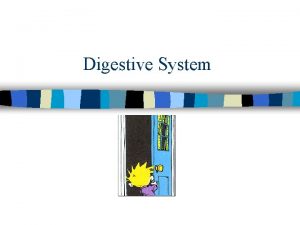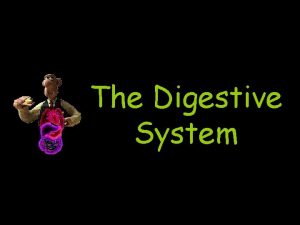DIGESTIVE SYSTEM THE DIGESTIVE SYSTEM The digestive systems















- Slides: 15

DIGESTIVE SYSTEM

THE DIGESTIVE SYSTEM The digestive system’s role is to break down food that you eat, absorb all nutrients from it, and eliminate waste products. There are several physical and chemical transformations that occur throughout the process.

BACKGROUND INFORMATION What is an enzyme?

BACKGROUND INFORMATION What is an enzyme? An enzyme is a complex protein that acts as a catalyst. This means it speeds up a chemical reaction. Examples: Amylase, protease, lactase, DNA helicase, nuclease

BACKGROUND INFORMATION Enzymes require specific conditions (temperature, p. H, etc) or they will denature and not work properly.

AREA 1: MOUTH Pharynx Mouth Salivary glands Esophagus

REVIEW QUESTION What keeps swallowed food from entering the respiratory system? Epiglottis What keeps food from rising into the nasal passageways? Uvula

INSIDE THE MOUTH What happens: 1. Teeth grind up food into smaller pieces 2. Amylase (in saliva) breaks down starch into smaller sugar molecules Why is this important: 1. It’s much easier for small pieces of food to move through the digestive system than big chunks. 2. Breaking down food exposes more surface area, which means digestion will happen faster #bigideainscience 2

INSIDE THE MOUTH What happens: 1. Teeth grind up food into smaller pieces 2. Amylase (in saliva) breaks down starch into smaller sugar molecules Why is this important: 3. Starch is too complex for our bodies to absorb. It needs to be broken down.

AFTER SWALLOWING What happens: The swallowed food is now referred to as the bolus. It is squeezed through the esophagus by muscular contractions. This process is known as peristalsis (like squeezing toothpaste out of a tube) This even works if you eat something while upside down, or in zero gravity.

INSIDE THE STOMACH What happens: Stomach acid (called Gastric acid, which is mainly hydrochloric acid) further breaks down your food. Another enzyme called protease breaks down proteins into smaller peptides (smaller chains of amino acids). Is this a physical or chemical transformation?

INSIDE THE STOMACH Why doesn't’t the acid in your stomach eat away at your stomach walls?

INSIDE THE STOMACH Why doesn't’t the acid in your stomach eat away at your stomach walls? Your stomach is coated with mucous (snot) which protects it from its own acid. Sometimes, this mucous can wear away, and you’ll feel severe stomach pain. This is called an ulcer.

INSIDE THE STOMACH What is something unwanted (such as a virus) is present in the stomach? The stomach will expel its contents back up the esophagus and out the mouth. This is vomiting.

STOMACH Acid Reflux: This is a condition in which acid from the stomach makes its way into the esophagus, causing a burning feeling. This is sometimes called heartburn (even though it has nothing to do with your heart). What can you do about this?
 Circularory system
Circularory system Chapter 38 digestive and excretory systems answer key
Chapter 38 digestive and excretory systems answer key Nervous system and digestive system
Nervous system and digestive system Decision support systems and intelligent systems
Decision support systems and intelligent systems Principles of complex systems for systems engineering
Principles of complex systems for systems engineering Embedded systems vs cyber physical systems
Embedded systems vs cyber physical systems Engineering elegant systems: theory of systems engineering
Engineering elegant systems: theory of systems engineering Hát kết hợp bộ gõ cơ thể
Hát kết hợp bộ gõ cơ thể Slidetodoc
Slidetodoc Bổ thể
Bổ thể Tỉ lệ cơ thể trẻ em
Tỉ lệ cơ thể trẻ em Voi kéo gỗ như thế nào
Voi kéo gỗ như thế nào Chụp tư thế worms-breton
Chụp tư thế worms-breton Hát lên người ơi
Hát lên người ơi Các môn thể thao bắt đầu bằng tiếng nhảy
Các môn thể thao bắt đầu bằng tiếng nhảy Thế nào là hệ số cao nhất
Thế nào là hệ số cao nhất

